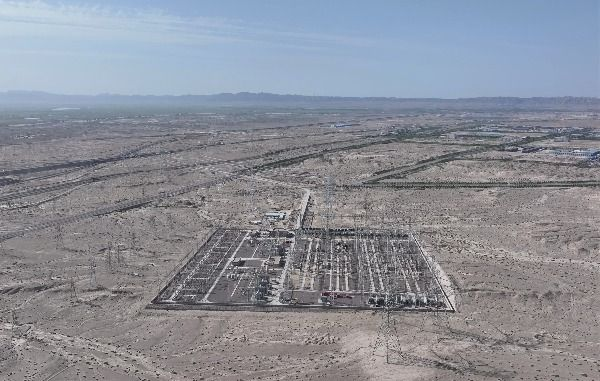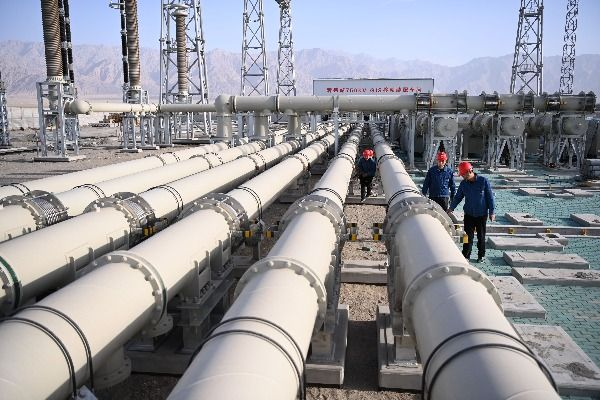Focus on Key Projects | China's Longest Desert Line Path 750kV Power Transmission Project Put into Operation
On December 14th, 2024, at 12:55, after two main transformers at the Ruoqiang 750kV substation completed five full-voltage shock tests, the Bazhou-Tieganlik-Ruoqiang 750kV power transmission project was officially put into operation. This marks the completion of China's largest single-investment 750kV power transmission project during the "14th Five-Year Plan" period, as well as the longest 750kV power transmission line in the desert. After commissioning, the power supply capacity in the Bazhou area of Xinjiang will increase by 1 million kilowatts, and the renewable energy channel capacity will increase by 1.7 million kilowatts.

Aerial photo of the Bazhou 750kV substation taken on August 29, 2024. (Photo by Ma Yuan)
In recent years, Xinjiang has focused on the national "Three Bases and One Corridor" positioning, vigorously developing renewable energy, striving to build a clean, low-carbon, safe, and efficient modern energy system, promoting the transformation of advantageous resources, and accelerating the creation of integrated demonstration projects for coal, electricity, oil, gas, wind, solar, and storage, as well as the formation of a million-kilowatt-scale clean energy supply guarantee zone around the Tarim Basin.
The Bazhou-Tieganlik-Ruoqiang 750kV power transmission project, as a key project for advancing the electrification of Xinjiang and supporting the construction of the Silk Road Economic Belt's core area, is an important part of the 750kV loop grid project around the Tarim Basin. The project starts from the Bazhou 750kV substation and ends at the Ruoqiang 750kV substation. With a dynamic investment of 4.613 billion yuan, it involves the construction of two 750kV substations with a capacity of 3 million kilovolt-amperes, 880 kilometers of 750kV transmission lines, and 1,873 iron towers. Construction began on March 25, 2023, and it was completed and put into operation after 21 months.

On August 2, 2024, on-site workers of the Bazhou-Tieganlik-Ruoqiang 750kV transmission line project performed acceptance and defect rectification operations. (Photo by Ma Yuan)
As the longest desert-line power transmission project in China, over 90% of the lines in this project are located in the southern part of the Taklamakan Desert, with nearly 400 kilometers of the line crossing the desert. The desert’s high mobility and strong winds make the excavation and formation rate for tower foundations extremely low. Builders used methods such as sandbag stacking and sand-blocking boards to prevent collapse during the excavation process, and introduced a "three-fast" construction method (quick excavation, quick preparation, quick pouring). This approach greatly saved construction time in desert areas and reduced construction safety risks. To address the dry climate and difficulty in concrete curing, builders used a "drip irrigation method" to ensure the quality of the concrete foundations by dripping water onto the tower bases using a specially designed device. Concrete curing film was wrapped around the surface to conserve water while enhancing insulation and moisture retention, ensuring high-quality concrete curing in the desert. Additionally, the supply plan was closely monitored, and timely adjustments were made during the project to ensure strong material support for the smooth completion of construction tasks.

On August 2, 2024, workers were conducting acceptance and defect rectification operations on the Bazhou-Tieganlik-Ruoqiang 750kV transmission line project. (Photo by Ma Yuan)
The project has 176.9 kilometers of lines crossing the Bosten Lake Scenic Area, Taitema Lake Wetland Park, and Poplar Forest. "Throughout the construction, we incorporated ecological protection concepts, increasing investment by over 10 million yuan. We optimized the route, increased tower height, adjusted tower spacing, reduced the number of towers in lake areas, and built work platforms to ensure harmony between the power grid and the ecosystem," said Li Jun, the project manager.

On December 9, 2023, the mobile dust-proof workshop at the Ruoqiang 750kV substation’s new construction project, where technicians were installing GIS equipment. (Photo by Ma Yuan)
The new Ruoqiang 750kV substation is an important part of the Bazhou-Tieganlik-Ruoqiang 750kV power transmission project and a crucial hub station. Located on the edge of the Taklamakan Desert, where wind and sand are prevalent, the project uses GIS equipment to become the first 750kV GIS substation in southern Xinjiang to reduce operational risks.
The installation of GIS equipment requires a high level of cleanliness and precise installation accuracy. With 35 compartments and 1,378 units, it is necessary to maintain a cleanliness level of millions and ensure a connection accuracy of within 2 millimeters, even in frequent sandstorm conditions. The difficulty of this operation is evident.
"To ensure the quality of GIS installation, we used a mobile dust-proof workshop. The workshop spans 27 meters east to west, 20 meters north to south, and stands 11 meters high, roughly the size of a basketball court. During operations, the mobile dust-proof workshop moved 20 times, with two 10-ton overhead cranes working simultaneously. The entire installation process took 90 days to complete," said Gan Xing, the project manager. To maintain a cleanliness level of millions, hard barriers were erected around the dust-proof workshop, and a dense network was laid with water sprinklers to cover the area. Environmental monitoring was also strengthened throughout the process.

Aerial photo of the new Ruoqiang 750kV substation taken on December 15, 2024. (Photo by Ma Yuan)
On December 7th, after the power transmission work began, State Grid Xinjiang Electric Power carried out on-site power transmission operations under the command of the Northwest Grid Dispatch, following the power transmission plan and schedule. The operation took 8 days, and the project was successfully commissioned.
After completion, the Bazhou-Ruoqiang area will form a "north-to-south connection and west-to-east transmission" 750kV backbone grid structure, which will strongly support the construction of the third AC power transmission channel from Xinjiang and promote the interconnection of the Xinjiang and Qinghai power grids. This will further enhance the power transmission capacity and transform Xinjiang’s energy advantages into economic advantages while supporting the national power supply security.
In the later stages, the project will be connected with the Ruoqiang-Qiemu and Qiemu-Minfen 750kV power transmission projects, forming a large 750kV ring network around the Tarim Basin, which will further optimize the main grid framework in southern Xinjiang and provide network support for the development of wind, solar, and water resources in the Tarim Basin.

On April 25, 2024, at the construction site of the new Ruoqiang 750kV substation, project supervisors inspected the 750kV GIS equipment in the area. (Photo by Ma Yuan)
According to statistics, as of now, the Xinjiang power grid has 30 750kV substations with a total capacity of 87.5 million kilovolt-amperes and 91 transmission lines spanning 12,037 kilometers, forming a "five-ring internal supply grid and four external transmission channels" network structure. According to the plan, by the end of the "14th Five-Year Plan," the Xinjiang power grid will form a "seven-ring internal supply grid and five external transmission channels" structure, providing strong momentum for converting Xinjiang's energy advantages into economic benefits. (Party Rui, Wu Tao, Ding Rushi)






